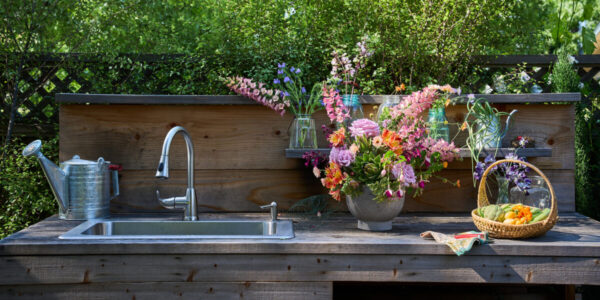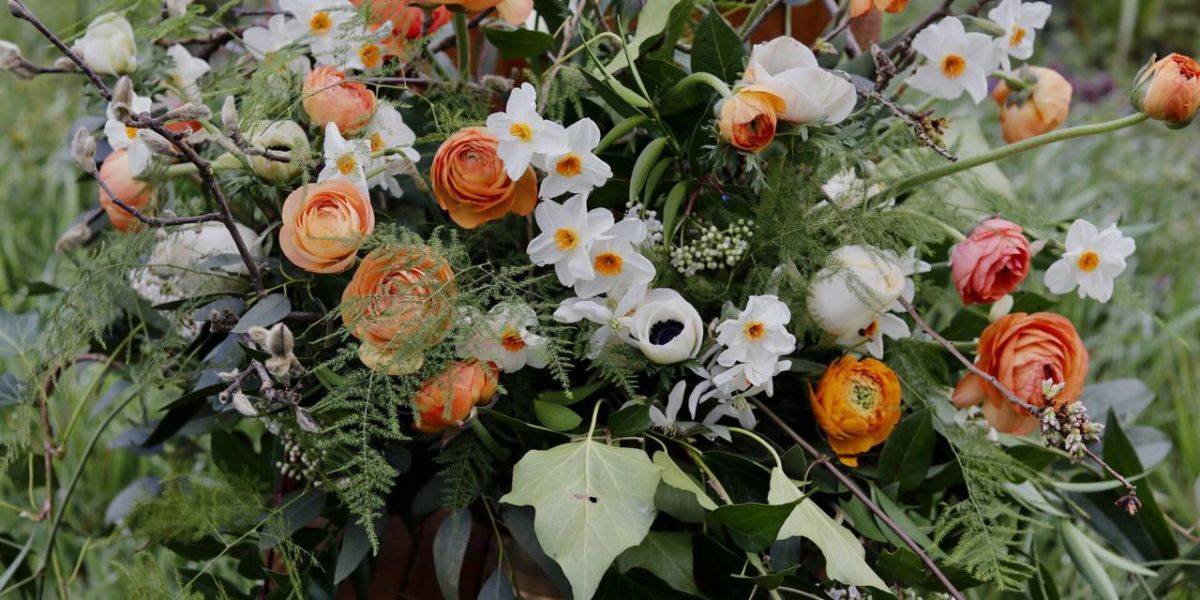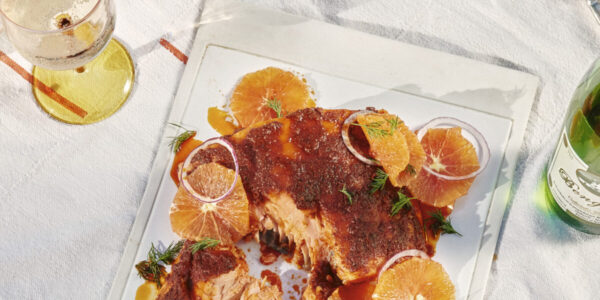
Your Ultimate Fall Planting Guide
Our picks for the very best bulbs, greens, trees, and more to set out now for a vibrant garden come spring.

Tempting as it may be to buy plants in spring when they’re looking full and luscious, the pros know that if you want to achieve your spring garden goals, fall planting is crucial. Autumn is the ideal time for getting most ornamentals and cool-season edibles into the ground: Once summer’s peak heat is behind us, the soil remains warm, and in many regions the following few months could bring merciful soaking winter rains. This can lead to deep root growth for all kinds of plants that will later reach their prime in spring, if not before. Here are our top picks, including some surprises—plus tips for planting them.
Japanese Maple
Most woody plants prefer a winter or fall planting time so they can settle in around the time they’re dormant. Some will provide spring blooms, of course, but of all the deciduous trees out there, we’re especially smitten with those whose leaves turn vivid fall hues, from rich red and gold to fiery orange and deep burgundy. At nurseries in early autumn, you can see them sporting their true fall tree colors before you buy. Our picks range from a dwarf container-size tree (Japanese maple) to a whopper that needs space to show it off best (ginkgo).
Japanese maple (Pictured). Choices include ‘Shaina’ (5 ft. tall; red foliage) and ‘Sango Kaku’ (25 ft. tall; yellow leaves).
Gingko. Fan-shaped leaves of this shapely tree (to 35 ft. tall or more) turn brilliant buttery yellow.
Chinese pistache. A good patio tree; 30 to 60 ft. tall, with luminous leaflets of orange and yellow to scarlet in fall.
Redbud. Cercis canadensis ‘Forest Pansy’ grows 25 to 35 ft. tall; autumn leaves are yellow to red.
Spring Bulbs
Pop easy-to-grow bulbs into the ground now for showy flowers come spring. Our picks below, unlike tulips, will return every year in the West’s mild climates. At the nursery, choose firm bulbs without soft or moldy spots. Plant them pointy end up in a site that gets full sun; once planted, keep the soil moist but not soggy. Find a wide variety at brentandbeckysbulbs.com
Freesia. Fragrant blossoms come in white, yellow, red, lavender, and orange. Set corms 2 inches deep and 2 inches apart. Plants disappear in summer (don’t water then).
Narcissus. These bloom in many sizes and shapes, mainly in shades of white to yellow. Try ‘Inbal’ and ‘Ziva’ for fragrance, ‘Gigantic Star’ for impact, or ‘Minnow’ for tiny blooms. Plant 6 to 8 inches apart.
Livable Lawns
If a lawn is part of your fall planting plan, consider a more drought-resitant grass species. Traditional lawns need lots of water; no good in this drought. So if you’re getting serious about slashing your water bill, now’s a good time to plant or replace the usual lawn with a low-water grass such as blue grama or a fescue blend such as Eco-Lawn (pictured; wildflowerfarm.com). In warm-winter areas, start seed in fall; where winters are cool, wait until spring. Prep the soil by tilling it 8 inches deep. Top with a 3- to 4-inch layer of organic compost. Till again; rake the area smooth. Water thoroughly, let the soil settle for a few days, then sow seed.
More great picks: Tufted hairgrass is a native bunchgrass (groworganic.com). Plant ‘Legacy’ and ‘UC Verde’, both buffalo grasses grown from plugs (highcountrygardens.com), in spring to midsummer.
Purple Pixie® Loropetalum
Pansy Party
Violas (Viola spp.; pansies and johnny jump-ups) are so much bang for the buck: Add them to your fall planting plan and you don’t even have to wait until spring to see them bloom. Beyond their obvious charm, ‘Cool Wave’ pansies are the most vigorous we’ve ever seen. The pretty mounds cover themselves with rich purple, white, and yellow flowers from fall into early summer. Plant in full sun; they’ll grow up to 8 inches tall and 30 inches wide.
Natives
Natives are all the rage for a reason: Many tolerate drought once their roots are established. They provide food to pollinators and birds. They’re not picky; unless your soil is compacted and drains poorly, don’t bother amending it before planting—most of these plants adapted to native soils long ago. And forget fertilizer; they rarely need it.
Many natives smell like the aromatic wild shrubs fringing your favorite hiking trails and will give your garden a sense of place. Use them to create an all-native backyard ecosystem mimicking your region’s indigenous plant communities, or mix natives with compatible plants that take the same conditions.
Start with young container-grown plants that aren’t rootbound; they may not be much to look at when first planted, but they’ll adapt more successfully than larger plants. Water thoroughly after planting, then carefully and steadily for the first summer or two. After that, many should do well with little or no supplemental water.
Perennials: Foliage
Semipermanent plants, some perennials are evergreen; others die to the ground at the end of each growing season, then reappear from roots the following year. Most need periodic division and replanting to look their finest. Grow them for their colorful foliage or for beautiful blooms.
The leaves of perennial foliage plants range from green to colorful enough to brighten any garden. One of our favorite foliage workhorses is heuchera, which comes in a variety of leaf shapes, from rounded to ruffled to scalloped, with colors ranging from burgundy, caramel, apricot, and bronze to vibrant chartreuse. The low perennials—about 1 to 3 feet tall and wide—are perfect in containers and borders. Give them full to part sun and regular water.
In the photo above are some more favorites, clockwise from top left: ‘Encore,’ ‘Lime Marmalade,’ ‘Neptune,’ ‘Kassandra,’ ‘Can Can,’ and ‘Crème Brûlée.’
Perennials: Flowers
The best perennials for fall planting after a dry summer are unthirsty bloomers such as salvia, gaura, and yarrow (pictured). All pump out striking flower clusters over a long season (from summer well into fall); many attract pollinators such as bees and hummingbirds. Grow the plants in a sunny spot where they’ll have enough room to reach full size, and water regularly for the first year or two, until the plants mature.
Most Delicious Garlic
It’s easy to buy garlic at markets. But there’s good reason to grow your own: You can’t beat the spicy flavor of homegrown hardneck varieties such as ‘Spanish Roja’. In spring, hardnecks send up a center flower stalk that you can use like scallions in cooking. (You need to snip it off anyway, to make the bulb grow larger.) Once the leaves die back next June, dig up the plants, brush off the soil, and store the bulbs until you’re ready to cook. And if garlic sprouts in your kitchen, pull apart the cloves and add them to your fall planting list—they’ll settle in nicely over winter. Sources: Territorial Seed Company (territorialseed.com), Hood River Garlic (hoodrivergarlic.com).
Wildflowers
In much of the West in spring, wildflowers carpet whole hillsides with brilliant blooms of yellow, orange, pink, blue, and white—especially after a rainy winter. You see annuals with willowy stems and crepe paper-thin petals that glow in the sunlight. And you see tough perennials that have thick petals saturated with color. But you don’t need a road trip to find wildflowers—they grow in garden beds and even in containers. Buy a seed mix designed for your climate; an ounce of seed can cover 100 square feet. Broadcast the seeds over weed-free soil in a sunny spot, following package instructions. Lightly rake the soil to cover the seeds. Oh, and pray for rain!
Supreme Sweet Peas
Don’t forget to add sweet peas to your fall planting or, come spring, you’ll be sorry! Among our favorites for fragrance: ‘Cupani’, a deep purple bicolor heirloom, and ‘April in Paris’, with wavy petals of creamy pale primrose yellow with a lilac flush. reneesgarden.com
Greens
Salad mixes are cool-season essentials—quick, easy, and tasty. Sow seeds before cold weather sets in (plants mature in about six weeks). Our pick: Baby Red Mix from Cook’s Garden (cooksgarden.com), for its colors, flavors, and textures. For cooking, try Renee’s Stirfry Mix, from Renee’s Garden Seeds (reneesgarden.com). It blends Asian red kale with tangy red mustard, mizspoona (a cross between sweet mizuna and succulent tatsoi), and a white-stemmed pak choi.
The Latest

